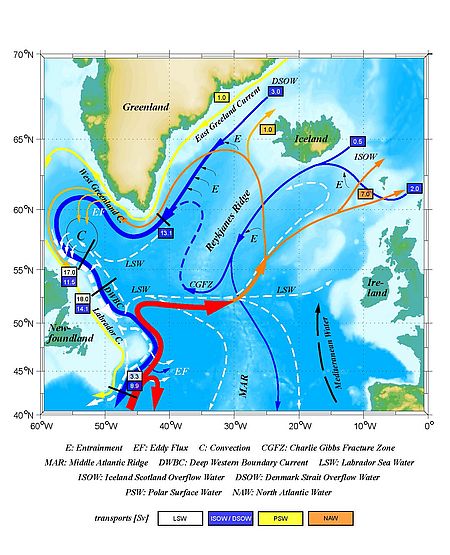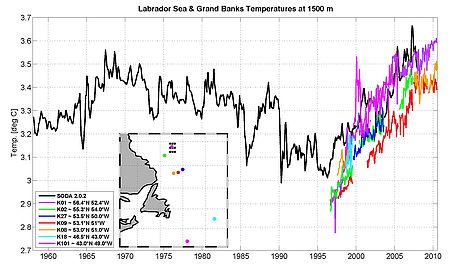North Atlantic RACE
Changes in ocean circulation along the western boundary of the subpolar North Atlantic
The exit of the Labrador Sea near 53°N is a key region of the thermohaline circulation (THC) where different components of the North Atlantic Deep Water merge to form the Deep Western Boundary Current (DWBC) (Fig. 1). Time series of temperature, salinity and currents show fluctuations in water mass properties of the DWBC on time scales of months all the way to decadal trends, such as an approximately 0.5°C warming per decade in the Labrador Sea Water (Fig. 2). Transports and individual currents of the DWBC also show variations on short to interannual time scales at all depth levels; however, a decadal trend is currently not evident.
The current program addresses the THC and DWBC variability on timescales from months to decades and their relationship to large-scale circulation and water mass variations as well as global climate change. Our field program consists essentially of a moored array which measures the deep boundary current along the continental slope off Labrador. The continuous record of water mass properties and transports in the key region at 53°N will also be combined with other monitoring components of the RACE program and is further embedded in international monitoring programs (THOR / NACLIM) dealing with THC variability in the subpolar North Atlantic. Because of the ocean’s signal-to-noise characteristics, only long-term observations, such as the 53°N array commenced in 1997, allow the robust determination of water mass properties and currents, which in turn serve as verification of numerical models. Such model verification is necessary to provide reliable statements on climate-induced changes in the ocean based on model results. Important components of the program are thus the comparative analysis and synthesis of products with high-resolution modeling (at GEOMAR) and the assimilation model studies at national and international levels.
One of the key questions of this investigation is whether the observation over the past 15 years, indicating an oceanic warming at depth, is part of a long-term trend of global warming. The comparison with model data (SODA assimilation model) shows (a) good agreement between model results and our (independent) measurements, and (b) that the warming is likely part of a long-period (multi-decadal) fluctuation.
The objectives of this study are:
- Determination of deep water transports at the exit of the Labrador Sea
- Quantitative determination of transport estimates and their accuracy which are caused by short-term fluctuations in the flow field
- Comparison of transports with high-resolution models for their verification
Participating Scientists
All at:
GEOMAR | Helmholtz Centre for Ocean Research Kiel, Düsternbrooker Weg 20, 24105 Kiel, Germany
Fax: +49 431 600 4102
|
Name |
Phone |
pers. Page |
|
+49 431 600-4106 |
|
|
|
+49 431 600-4100 |
||
| Prof. Dr. Torsten Kanzow | +49-431-600 4150 | |
|
+49 431 600-4156 |
|
|
|
+49 431 600-4111 |
|




